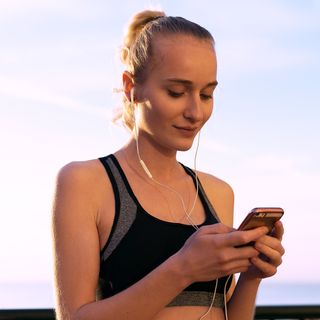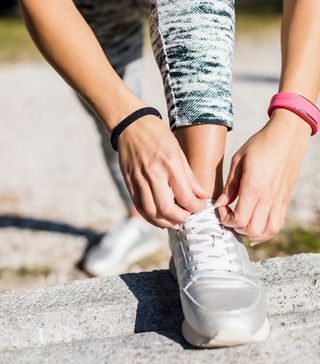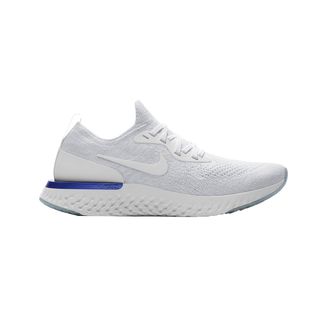I Have a Degree in Exercise Science—Here's What I've Learned About Working Out
Fitness can be so much more than a physical challenge. The right workout can break us open in profound ways, revealing truths about our perseverance and inner strength that might have been otherwise invisible. It’s therapy. It’s meditation. And sometimes, it can be hugely transformative. With this in mind, we invited some of our readers to share their own stories of the workout that changed everything—how they found their ideal form of movement and what it taught them about themselves. Below, Natalie DiCicco shares how her fitness journey merged with her mental health.

If you’d asked me to run a half-marathon five years ago, I would’ve laughed in your face. The only way I would have run is if a bear were chasing me, and even then, I certainly wouldn’t make it 13 miles. But life has a funny way of turning things upside down, right?
In the summer of 2014, I was heading into my senior year of college pursuing a BS in exercise science, and while I had started exercising regularly somewhere between my sophomore and junior years, I certainly wasn’t running. It seemed crazy to me that people did that kind of thing for pleasure. Running? Seriously? I’ll stay right here on the elliptical in the air-conditioned gym with a television in front of my face, thank you very much.
As you could probably guess, when you major in exercise science, everyone in your classes is pretty psyched about fitness. And for whatever reason, the better majority of my class was really into running. We had a Run Club in our department that met two days a week, where exercise science students and faculty would meet up and run a three-mile loop around campus. That seemed pretty cool, and I wanted to fit in. I’m pretty sure that’s how I started running. I certainly didn’t start off with Run Club. I didn’t want to embarrass myself in front of all my professors and classmates. So instead, I started running a mile here and there on the treadmill. And then on the track. And then outside.
In October of my senior year, after a one-and-a-half-mile run through our college town, I walked into my apartment one day, looked my roommates dead in the eyes, and said, “I’m going to run the next Pittsburgh Half-Marathon.” I’ve always been “the funny friend,” but I don’t think I’ve ever made them laugh so hard in my life. At first, they thought I was kidding. Then they thought I was insane. And honestly, I kind of agreed with them.
I think I surprised myself just as much as I surprised everyone else with my self-discipline. From waking up early on Saturdays to fit in my long runs to squeezing in an extra yoga session in between class and my three part-time jobs to help alleviate some of the tightness in my hips, I was all in. And just like that, one week before walking across the stage to receive my diploma, I ran across the finish line of the 2015 Pittsburgh Half-Marathon. I’d never been so proud.
Since then, I’ve relocated from Western Pennsylvania to Northwestern North Carolina, earned a master of science in health and exercise science, and conquered the 13.1 distance three more times (and improved my time by 13 minutes). This fall, I’ll be training for my fifth and aiming for another PR. I’ve also decided that 2019 will be my year to run a full marathon. I think it’s officially safe to call myself a runner—yet I wouldn’t name running as the exercise that changed my life.
Working in corporate wellness is a really eye-opening experience, especially after spending six years of my life in the “health and fitness” bubble of college and graduate school. In a perfect world, everyone would be as health-conscious and physically active as the individuals in my classes. But in reality, that’s not at all the case. Considering my educational background, I think my role is really unique in that I spend more time focusing on how to help people become more active in their day-to-day lives than developing structured, goal-oriented exercise programs.
The reality of corporate America is that not everyone has the time or desire to spend hours in the gym or squeeze in a high-intensity workout before heading into the office. And honestly, there’s nothing wrong with that. While decades of research have shown us that exercise is an important part of maintaining overall health and preventing chronic disease, a growing body of literature also supports the fact that simply reducing sedentary time can significantly benefit one’s health. That means moving more, in any capacity, is good for us—both physically and mentally.

An alarming number of my clients struggle with high stress, anxiety, and depression, and I’ve always been a firm believer in promoting physical activity—walking, yoga, etc.—as a coping mechanism for these individuals. But you know how they say you should always practice what you preach? I really wasn’t doing that about a year ago.
During graduate school, I was diagnosed with anxiety and depression, and two of my biggest challenges were extreme fatigue and a decreased desire to participate in activities I once enjoyed (aka exercising). After months of counseling, trying prescription medications, and over $1000 in co-pays, I was feeling pretty helpless. At that point, I had sabotaged my relationship, lost a few friends, and racked up a lot of credit card debt spending more than I had on drinks while bar-hopping every weekend.
Keep in mind that in the midst of all this, I was working full-time as a health coach. I was someone who my clients were looking to for motivation and accountability. I felt like a fraud. How could I coach these people when I can hardly get myself out of bed in the morning, let alone to the gym?
It took some time, but I finally had an epiphany in one of my counseling sessions. I started journaling to keep track of my habits and symptoms to see if I could pick out any trends or patterns, and it honestly didn’t take more than one week to reach that aha moment.
There were several things that I noticed directly correlated to my symptoms or mood on a daily basis, but the one that was most apparent was my level of physical activity—how much I moved that day. I’ve worn a Fitbit or Garmin for as long as I can remember, so I used that to keep track of what I was doing each day.
Surprise, surprise: On the days I sat at my desk for my entire eight- to 10-hour workday, I was more fatigued. Likewise, on the days I hit the snooze button in the morning instead of giving myself extra time to take my dog for a long walk, I felt more depressed and had more trouble concentrating. And on the days when my Fitbit counted less than 7000 steps, I was having the most trouble staying awake and drinking almost triple the amount of coffee as a result. You might be thinking: “Duh, Natalie! You tell your clients these things every single day! Why is this a surprise to you?” But I’m just as human as anyone.
I think we all can think of one scenario in life that we’re sure would never happen to us. For me, it was being diagnosed with a mental health disorder. When I was younger, I always thought depression was just a word people used to sugarcoat laziness. I couldn’t wrap my head around the fact that it was completely out of the person’s control. It all makes sense to me now, and while I still have bad days more often than I’d like to admit, I’m heading in the right direction. Staying active has been a huge part of that.
For me, the exercise that changed everything wasn’t the mileage that led to a medal or the weeks of training that preceded a PR. The exercise that changed everything was the 30-minute morning walk with my dog. It’s taking the stairs rather than the elevator. It’s taking a walk around the building during my breaks instead of reaching for a third—or fourth—cup of coffee. The exercise that changed everything, for me, was the exercise that I didn’t think counted as exercise at all.
Next up: Learn how strength training transformed one reader’s relationship with her body.
Disclaimer
This article is provided for informational purposes only and is not intended to be used in the place of advice of your physician or other medical professionals. You should always consult with your doctor or healthcare provider first with any health-related questions.
